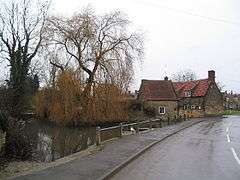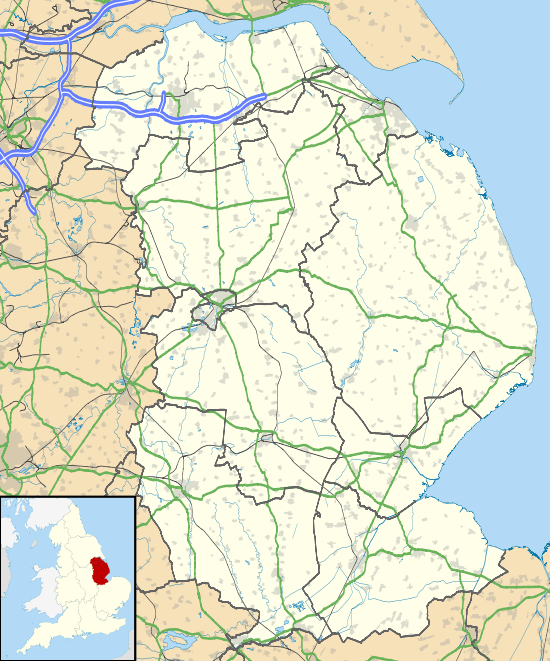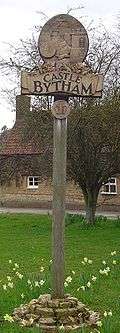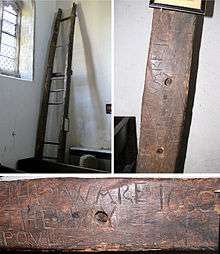Castle Bytham
Castle Bytham is a village and civil parish of around 300 houses in South Kesteven, Lincolnshire, England. The population was measured at 768 in 317 households at the 2011 census.[2]
| Castle Bytham | |
|---|---|
 Castle Bytham village pond | |
 Castle Bytham Location within Lincolnshire | |
| Population | 768 (2011 census) |
| OS grid reference | SK989185 |
| • London | 90 mi (140 km) S |
| Civil parish |
|
| District | |
| Shire county | |
| Region | |
| Country | England |
| Sovereign state | United Kingdom |
| Post town | GRANTHAM |
| Postcode district | NG33 |
| Dialling code | 01780 |
| Police | Lincolnshire |
| Fire | Lincolnshire |
| Ambulance | East Midlands |
| UK Parliament | |
At one time the village was an important commercial centre for the surrounding agricultural communities, but it is now largely a dormitory, although a number of farming families remain with a much reduced workforce.[3]
History
The name 'Bytham' is first recorded in 1067 (as a monastery that rapidly translated to Vaudey Abbey), and comes from the Old English word bythme meaning Valley bottom, broad valley.[5] In the Domesday survey of 1086 the village was known as West Bytham[6] as the castle had yet to be built. People have named the river that runs through the village the Tham or Am as a back-formation from the village name.
Morkery Wood housed a former bomb dump during the Second World War for the nearby airfields. In the early hours of 19 November 1942 Handley Page Halifax BB209 NP-G[7] of 158 Sqn, from RAF Rufforth in North Yorkshire, crashed near Stocken Hall Farm (in the wood). It had been hit by flak south-east of Paris coming back from a raid on Turin, Italy.[8] Half the aircrew were in the RCAF.
Castle
Overlooking the village is an 11th-century Norman castle mound.[9] The site of the castle in Saxon times was owned by Morcar, also known as Morkere, who was the brother of Ealdgyth, wife of King Harold. The castle, which gave its name to the village, was built soon after the Norman conquest and was given by the Conqueror to his half brother Odo, Bishop of Bayeux and Earl of Kent;[10] it was later owned by William le Gros, 1st Earl of Albemarle, and was burnt in the 15th century during the Wars of the Roses.[10]
In 1221, after a siege, the castle was destroyed by Henry III with the help of Hugh de Mortimer and William de Warenne, 5th Earl of Surrey. It had been defended by William de Forz, 3rd Earl of Albemarle aided by William d'Aubigny, Sir Richard Siward, and Henry de Hastings.
In the 16th century John Leland described remnants of the castle: "yet remained great walls of buildings".[10]
Geography

The nearest town is Stamford (even though Castle Bytham is in the Grantham postal area, with a Nottingham postcode). It is at the apex of the NG (Grantham), LE (Rutland) and PE (Stamford) postcodes.
The village is very close to the Rutland boundary. The civil parish extends much to the north-west of the village, up to Woolley's Lane, including Red Barn Quarry, owned by Bullimores. It also extends westwards to include all of Morkery Wood (originally named Morkerhaw - named after the Saxon earl Morcar mentioned above).[11] South of the A1 interchange to Woolley's Lane, the parish boundary is with North Witham, including Park House Farm. The eastern buildings of Stocken Hall Farm lie in the parish (with an LE15 postcode), with the rest in Stretton. To the east, Little Haw Wood is also in the parish.
Southwards, the civil parish extends to (and includes) Pillowsyke Holt, a piece of woodland near Holywell. Eastwards, the parish extends for about half a mile, where it includes the 30 acre Lawn Wood[12] which has been a nature reserve since 1995, joining two neighbouring meadows that were donated to Lincolnshire Wildlife Trust in 1993. The meadows are a good site for buttercups and yellow rattle, and are managed to encourage butterflies, including the ringlet, and the meadow brown. The wood is mainly oak and ash, but includes field maple, midland hawthorn and the uncommon wild service tree; woodland flora such as wood anemone, woodruff and early purple orchid also found there. Fallow deer and red deer are frequently seen in the reserve.[12]
Surrounding area
About 1 mile (2 km) to the east lies Little Bytham. The two villages used to be called West and East Bytham.[3]
To the west, on the western side of the A1 road, is South Witham near the source of the River Witham. The village's vicar, and that of the Bythams Group, is also the wife of the vicar of South Witham.
Between the village and the A1 the Lincolnshire Wildlife Trust maintains an important wildlife reserve at Tortoiseshell Wood[13] (which borders on to the west of the civil parish) and some of the road verges are protected for wildlife by Lincolnshire County Council. Tortoiseshell Wood is in the parish of North Witham, although the edge lies on the parish boundary.
West of the village, towards Clipsham, is a Yew Tree Avenue maintained by the Forestry Commission, the trees cut into large topiary forms.
Community
 St James's Church
St James's Church Former school
Former school Castle Inn public house
Castle Inn public house Fox and Hounds public house
Fox and Hounds public house
The Ecclesiastical parish is part of the Castle Bytham with Creeton group of the Deanery of Beltisloe. The incumbent is Revd S M Evans.[4][14][15]
Castle Bytham's community supports several events each year in the village hall. Every year Castle Bytham holds a midsummer fair and street market, with stalls, a duck grand prix, dog show, funfair, children's games, beer tents and barbecues. The fair has raised over £40,000 for local causes including a Christmas lunch for pensioners and a children's party, and village infrastructure improvements. Efforts are currently being made to improve the village recreation ground for the benefit of local young people and a 2010 Parish Plan suggested wider improvements.
The former RAF Coningsby station commander (1974-60) and Commandant of the Central Flying School (1979–83) lives in the village, and a former resident on Glen Road was Harold Wilson's press secretary, Sir Trevor Lloyd-Hughes.[16][17]
There is a village shop on Pinfold Road. Castle Bytham Post Office[18] was closed in 2008 despite local opposition. It had served Creeton, Swinstead, Swayfield, Little Bytham and Clipsham, and other nearby small villages – it has now been replaced by a mobile 'outreach' service.
There are two remaining public houses in the village: the Fox & Hounds and the Castle Inn. The New Inn on Station Road was converted to housing in the 1960s.[3]
Former railway station
The village had a railway station on the Midland and Great Northern Joint Railway, the remains of which can still be seen. This railway station was rather unusual, being a single platform in a deep cutting through the village. The railway station was not originally planned by the railway, but was added after considerable local lobbying.[19][20] It remained open, as did the goods yard on the other side of the road, until the line closed in 1959.[3][20][21][22] West of the village the line of the railway now forms a road crossing under the A1.
Places of worship
The church, started in the 12th century, and restored in 1900, is dedicated to St James[23] and is one of a group of parishes in the rural deanery of Beltisloe. It contains an unusual memento of the English Restoration: a ladder, formerly used in the tower, with a carved inscription which reads "THIS WARE THE MAY POVL 1660"[10] (see photograph), suggesting that May celebrations were held in the village (as they were throughout the country) to mark the return to the throne of King Charles II.[4]
There was at one time a Methodist chapel in High Street (now a private house), served by visiting ministers from Stamford.[24] On its closure in 1972 the Methodist Circuit still sent a preacher to the village for a few years, service taking place in the parish church.
Publications
- Wild, John, (1871); The History of Castle Bytham: Its Ancient Fortress and Manor BiblioBazaar (2008) ISBN 0-554-79494-2 / Nabu Press (2010) ISBN 978-1-147-70286-6
- Chorlton, Martyn; Danger Area: The Complete History of RAF South Witham, 100 MU Old Forge Publishing (2003) ISBN 0-9544507-2-8
See also
- Castle Bytham Quarry
- Little Bytham
- Bytham Castle
- Bytham River
- Parish outline map
References
- "Civil Parish details". Lincolnshire county council.
- "Civil parish population 2011". Neighbourhood Statistics. Office for National Statistics. Retrieved 25 April 2016.
- "SKDC conservation area report".
- "Welcome to Castle Bytham".
- Mills, A.D. Oxford Dictionary of British place-names. Oxford University Press. p. 90. ISBN 978-0-19-852758-9.
- Wild, John, (1871); The History of Castle Bytham: Its Ancient Fortress and Manor p. 3; BiblioBazaar (2008) ISBN 0-554-79494-2 / Nabu Press (2010) ISBN 978-1-147-70286-6
- 1942 Handley-Page Halifax crash
- Lost Bombers
- Historic England. "The Castle (325283)". PastScape. Retrieved 18 August 2009.
- Cox, J. Charles (1916); Lincolnshire, Methuen & Co. Ltd., p.96
- Cope-Faulkner, Paul (October 2001). "Forest Enterprise Woodlands in Lincolnshire - Morkery Wood - Archaeological Survey (APS Report No 65/01)" (PDF). Archaeological Project Services. Retrieved 8 June 2012.
- "Lincolnshire wildlife trust - Lawn Wood". Archived from the original on 25 May 2010.
- "Lincolnshire wildlife trust - Tortoiseshell wood". Archived from the original on 11 November 2007.
- "TheBythams.org.uk". community web site
- "Eclessiastical parish details". Archived from the original on 21 September 2013.
- Stamford Mercury
- Sir Trevor Lloyd-Hughes
- Castle Bytham Post Office geograph.org.uk
- Squires, Stewart; Hollamby, Ken, eds. (2009). Building a Railway: Bourne to Saxby. Lincoln Record Society. ISBN 978-0-901503-86-2.
- Back, Michael (2009). Branch lines around Spalding: M&GN Saxby to Long Sutton. Middleton Press.
- Hill, Roger; Vessey, Carey (1995). British Railways Past and Present - 27 Lincolnshire. Past & Present Publishing.
- Historic England. "The railway station (506989)". PastScape. Retrieved 27 January 2011.
- Historic England. "St James' church (325286)". PastScape. Retrieved 16 March 2013.
- "Methodist circuit's own history". Archived from the original on 27 August 2011. Retrieved 27 January 2011.
External links
![]()
- "Local web site".
- "Village web site".
- "Summer Fair web site".
- Photographic history of Castle Bytham
- History of the village
- Lawn Wood, Bottleneck and Jacksons nature reserve
- "History of Castle Bytham, in South Kesteven and Lincolnshire". A Vision of Britain through Time. GB Historical GIS / University of Portsmouth. Retrieved 19 August 2013.
- "all 26 records for the parish". PastScape. English Heritage. Retrieved 19 August 2013.
- "Funeral march for village post office", Stamford and Rutland Mercury, 1 November 2007
- "How DNA saved an 'extinct' breed", BBC News, 20 August 2004
- "Farmer jailed over cannabis find", BBC News, 21 November 2003
